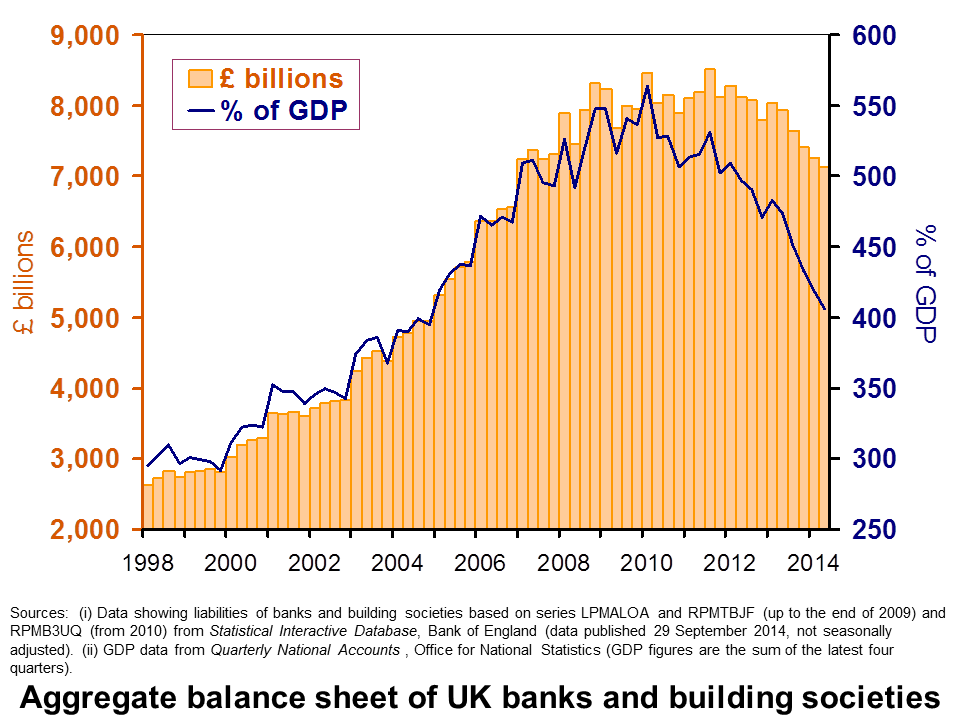 Lloyds Banking Group has announced that it plans to reduce its labour force by 9000. Some of this reduction may be achieved by not replacing staff that leave, but some may have to be achieved through redundancies.
Lloyds Banking Group has announced that it plans to reduce its labour force by 9000. Some of this reduction may be achieved by not replacing staff that leave, but some may have to be achieved through redundancies.
The reasons given for the reduction in jobs are technological change and changes in customer practice. More banking services are available online and customers are making more use of these services and less use of branch banking. Also, the increasingly widespread availability of cash machines (ATMs) means that fewer people withdraw cash from branches.
And it’s not just outside branches that technological change is impacting on bank jobs. Much of the work previously done by humans is now done by software programs.
One result is that many bank branches have closed. Lloyds says that the latest planned changes will see 150 fewer branches – 6.7% of its network of 2250.
What’s happening in banking is happening much more widely across modern economies. Online shopping is reducing the need for physical shops. Computers in offices are reducing the need, in many cases, for office staff. More sophisticated machines, often controlled by increasingly sophisticated computers, are replacing jobs in manufacturing.
So is this bad news for employees? It is if you are in one of those industries cutting employment. But new jobs are being created as the economy expands. So if you have a good set of skills and are willing to retrain and possibly move home, it might be relatively easy to find a new, albeit different, job.
As far as total unemployment is concerned, more rapid changes in technology create a rise in frictional and structural unemployment. This can be minimised, however, or even reduced, if there is greater labour mobility. This can be achieved by better training, education and the development of transferable skills in a more adaptive labour force, where people see changing jobs as a ‘normal’ part of a career.
Webcasts
 Lloyds Bank cuts 9,000 jobs – but what of the tech future? Channel 4 News, Symeon Brown (28/10/14)
Lloyds Bank cuts 9,000 jobs – but what of the tech future? Channel 4 News, Symeon Brown (28/10/14)
 Lloyds Bank confirms 9,000 job losses and branch closures BBC News, Kamal Ahmed (28/10/14)
Lloyds Bank confirms 9,000 job losses and branch closures BBC News, Kamal Ahmed (28/10/14)
Article
Lloyds job cuts show the technology axe still swings for white collar workers The Guardian, Phillip Inman (28/10/14)
Reports
Unleashing Aspiration: The Final Report of the Panel on Fair Access to the Professions Cabinet Office (July 2009)
Fair access to professional careers: a progress report Cabinet Office (30/5/12)
Questions
- Is a reduction in banking jobs inevitable? Explain.
- What could banks do to reduce the hardship to employees from a reduction in employment?
- What other industries are likely to see significant job losses resulting from technological progress?
- Distinguish between demand-deficient, real-wage, structural and frictional unemployment. Which of these are an example, or examples, of equilibrium unemployment?
- What policies could the government pursue to reduce (a) frictional unemployment; (b) structural unemployment?
- What types of industry are likely to see an increase in employment and in what areas of these industries?
 In the Blog, A VW recession for the eurozone, as German growth revised down?, we discussed the pessimistic outlook for the eurozone, in part driven by the problems facing the engine of Europe: Germany. While the German government noted that the weak growth figures are due to external factors, it appears as though these external factors are now sending waves through the domestic economy.
In the Blog, A VW recession for the eurozone, as German growth revised down?, we discussed the pessimistic outlook for the eurozone, in part driven by the problems facing the engine of Europe: Germany. While the German government noted that the weak growth figures are due to external factors, it appears as though these external factors are now sending waves through the domestic economy.
Over the past 6 months, German confidence has fallen continuously and now stands at almost its lowest level in 2 years. Think tank data from a survey of 7000 firms in Germany fell from 104.7 to 103.2 for October – the weakest reading since December 2012. Confidence is always a key factor in the strength of an economy, as it affects consumers and businesses.  Without consumer and business confidence, two key components of aggregate demand are weak and this downward pressure on total spending in the economy depresses economic growth. An economist from Ifo, the think-tank that produced this business climate index, said that firms felt ‘downbeat about both their current situation and the future.’
Without consumer and business confidence, two key components of aggregate demand are weak and this downward pressure on total spending in the economy depresses economic growth. An economist from Ifo, the think-tank that produced this business climate index, said that firms felt ‘downbeat about both their current situation and the future.’
As confidence continues to decline in Germany, the economic situation is unlikely to improve. Unfortunately, it is something of a vicious circle in that without economic growth confidence won’t return and without confidence, economic growth won’t improve. The industrial sector is crucial to Germany and the data is concerning, according to Chief economist at Commerzbank, Joerg Kraemer:
The latest numbers from the industrial sector are very worrisome…The third quarter was probably worse than expected, the economy may have stagnated at best.
Numerous factors continue to depress the German economy and while negative growth is not expected, estimates for quarterly growth from July to September remain at around 0.3%. As Europe’s largest economy, such low growth rates will be of concern to the rest of the Eurozone and may also bring worry to other countries, such as the US and UK. With growing interdependence between nations, the success of countries such as Germany and Europe as a whole influences the economic situation abroad. Commentators will be looking for any signal that Germany is strengthening in the coming months and an improvement in business confidence will be essential for any prolonged recovery.
German business confidence falters again in October Wall Street Journal, Todd Buell (27/10/14)
German business morale weakens to lowest level in almost two years Reuters, Michelle Martin (27/10/14)
Zero growth best hope for Germany as confidence disappears The Telegraph, Szu Ping Chan (27/10/14)
German Ifo business confidence drops for sixth month Bloomberg, Stefan Riecher (27/10/14)
German business confidence plunges again as analysts urge fiscal stimulus International Business Times, Finnbarr Bermingham (27/10/14)
German business confidence falls again, Ifo says BBC News (27/10/14)
German business confidence tumbles The Guardian, Philip Inman (24/9/14)
The German way of stagnating BBC News, Robert Peston (11/11/14)
Questions
- Why is consumer and business confidence such an important element in explaining the state of an economy?
- Use an AD/AS diagram to illustrate the impact on national output of a decline business confidence. What are the other consequences for the macroeconomic objectives?
- What actions can a government take to boost confidence in an economy?
- If economic growth is weak and confidence is low, is there any point in cutting interest rates as a means of stimulating investment?
- If the eurozone did move back into recession, what could be the possible consequences for countries such as the UK and US?
- How useful are indices that measure business confidence?
 Following the financial crisis, all sectors of the economy continue to repair their balance sheets. As well as households, non-financial corporations and government, this is true of the banking sector. In part, the repairing and rebalancing of their balance sheets is being brought about by regulatory pressures. The objective is to make banks more resilient to shocks and less susceptible to financial distress.
Following the financial crisis, all sectors of the economy continue to repair their balance sheets. As well as households, non-financial corporations and government, this is true of the banking sector. In part, the repairing and rebalancing of their balance sheets is being brought about by regulatory pressures. The objective is to make banks more resilient to shocks and less susceptible to financial distress.
The need for banks to repair and rebalance their balance sheets is significant because of their systemic importance to the modern-day economy. Financial institutions that are systemically important to national economies are know as SIFIs (systemically important financial institutions) while those of systemic importance to the global economy are know as G-SIFIs or G-SIBs (global systemically important banks). The increasing importance of financial institutions to economic activity is known as financialisation.
 One way of measuring the degree of financialisation here in the UK is to consider the aggregate size of the balance sheet of resident UK banks and building societies (including foreign subsidiaries operating here). The chart shows that the balance sheet grew from £2.6 trillion in 1998 Q1 to £8.5 trillion in 2010 Q1. Another way of looking at this is to consider this growth relative to GDP. This reveals that the aggregate balance sheet of banks and building societies grew over this period from 3 times annual GDP to a staggering 5.6 times GDP. (Click here for a PowerPoint of the chart.)
One way of measuring the degree of financialisation here in the UK is to consider the aggregate size of the balance sheet of resident UK banks and building societies (including foreign subsidiaries operating here). The chart shows that the balance sheet grew from £2.6 trillion in 1998 Q1 to £8.5 trillion in 2010 Q1. Another way of looking at this is to consider this growth relative to GDP. This reveals that the aggregate balance sheet of banks and building societies grew over this period from 3 times annual GDP to a staggering 5.6 times GDP. (Click here for a PowerPoint of the chart.)
But, now consider the aggregate banking balance sheet in the 2010s. This reveals a shrinking balance sheet. At the end of the second quarter of this year (2014 Q2) it had fallen back to £7.1 trillion or 4 times GDP. As a share of GDP, this was the smallest the aggregate balance sheet had been since 2005 Q1.
Does a shrinking balance sheet matter? This is where the analysis becomes tricky and open to debate. If the smaller size is consistent with a more stable financial system then undoubtedly that is a good thing. But, size is not that all matters. The composition of the balance sheet matters too. This requires an analysis of, among other things, the liquidity of assets (i.e. assets that can be readily turned in a given amount of cash), the reliability of the income flow from assets and the resources available to withstand periods of slow economic growth, including recessions, or periods of financial difficulty.
As we have identified before (see Financialisation: Banks and the economy after the crisis), the financial crisis could herald new norms for the banking system with important implications for the economy. If so, we may need to become accustomed to consistently lower flows of credit and not to the levels that we saw prior to the financial crisis of the late 2000s. However, an alternative view is that we are merely experiencing a pause before the next expansionary phase of the credit cycle. This is consistent with the financial instability hypothesis (see Keeping a Minsky-eye on credit) which argues that credit cycles are an integral part of modern financialised economies. Only time will tell which view will turn out to be right.
Articles
‘Cleaning up bank balance sheets is key’ Irish Examiner, John Walsh (10/10/14)
More action needed at European banks: Fitch Courier Mail, (17/10/14)
Bank lending to small businesses falls by £400m The Telegraph, Rebecca Burn-Callander (20/10/14)
Bank lending to SMEs falls by £400m SME insider, Lindsey Kennedy (21/10/14)
Record world debt could trigger new financial crisis, Geneva report warns The Guardian, Phillip Inman (29/10/14)
RBS shares jump as bank’s bad debts improve The Guardian, Jill Treanor (30/10/14)
Data
Statistical Interactive Database Bank of England
Questions
- Using examples, demonstrate your understanding of financialisation.
- Draw up a list of the alternative ways in which we might measure financialisation.
- What factors are likely to explain the recent reduction in the aggregate balance sheet of resident banks and building societies in the UK?
- How might we go about assessing whether the aggregate level of lending by financial institutions is sustainable?
- How might we go about assessing whether the level of lending by individual financial institutions is sustainable?
- How would reduced flows of credit be expected to impact on the economy both in the short term and in the longer term?
- Are credit cycles inevitable?
- Of what significance are credit cycles in explaining the business cycle?
 The market structure in which firms operate has important implications for prices, products, suppliers and profits. In competitive markets, we expect to see low prices, many firms competing with new innovations and firm behavior that is in, or at least not against the public interest. As a firm becomes dominant in a market, its behavior is likely to change and consumers and suppliers can be adversely affected. Is this the case with Amazon?
The market structure in which firms operate has important implications for prices, products, suppliers and profits. In competitive markets, we expect to see low prices, many firms competing with new innovations and firm behavior that is in, or at least not against the public interest. As a firm becomes dominant in a market, its behavior is likely to change and consumers and suppliers can be adversely affected. Is this the case with Amazon?
Much attention has been given to the dispute centering around Amazon and its actions in the market for e-books, where it holds close to two thirds of the market share. Critics of Amazon suggest that this is just one example of Amazon using its monopoly power to exploit consumers and suppliers, including the publishers and their authors. Although Amazon is not breaking any laws, there are suggestions that its behavior is ‘brutal’ and is taking advantage of consumers, suppliers and its workforce.
But rather than criticizing the actions of a monopolist like Amazon, should we instead be praising the company and its ability to compete other firms out of the market? One of the main reasons why consumers use Amazon to buy goods is that prices are cheap. So, in this respect, perhaps Amazon is not acting against consumers’ interests, as under a monopoly we typically expect low output and high prices, relative to a model of perfect competition. The question of the methods used to keep prices so low is another matter. Two conflicting views on Amazon can be seen from Annie Lowrey and Franklin Foer, who respectively said:
“Amazon relentlessly drives down prices for goods and services and delivers them fast and cheap. It ploughs its profits into price cuts and innovation rather than putting them in the hands of its investors. That benefits millions of families – full stop.”
“In effect, we’ve been thrust back 100 years to a time when the law was not up to the task of protecting the threats to democracy posed by monopoly; a time when the new nature of the corporation demanded a significant revision of government.”
So, with Amazon we have an interesting case of a monopolist, where many aspects of its behaviour fit exactly into the mould of the traditional monopolist. But, some of the outcomes we observe indicate a more competitive market. Paul Krugman has been relatively blunt in his opinion that Amazon’s dominance is bad for America. His comments are timely, given the recognition for Jean Tirole’s work in considering the problems faced when trying to regulate any firm that has significant market power. He has been awarded the Nobel Prize in Economics. I’ll leave you to decide where you place this company on the traditional spectrum of market structures, as you read the following articles.
Amazon: Monopoly or capitalist success story? BBC News, Kierran Petersen (14/10/14)
Why the Justice Department won’t go after Amazon, even though Paul Krugman thinks it’s hurting America Business Insider, Erin Fuchs (20/10/14)
Is Amazon a monopoly? The Week, Sergio Hernandez (19/11/14)
Big, bad Amazon The Economist (20/10/14)
Questions
- What are the typical characteristics of a monopoly? To what extent does Amazon fit into this market structure?
- Why does Paul Krugman suggest that Amazon is hurting America?
- How does Amazon’s behaviour with regard to (a) its suppliers and (b) its workers affect its profitability? Would it be able to behave in this way if it were a smaller company?
- Why is Amazon able to charge its customers such low prices? Why does it do this, given its market power?
- Is there an argument for more regulation of firms with such dominance in a market, as is the case with Amazon?
- The debate over e-books is ingoing. What is the argument for publishers to be able to set a minimum price? What is the argument against this?
- Should customers boycott Amazon in a protest over the alleged working conditions of Amazon factory employees?
 The housing market and what to do about bubbles, second homes and first time buyers is likely to be one of many battle grounds at the next election. For many years, the idea of a mansion tax has been debated and the Shadow Chancellor, Ed Balls, has outlined plans for a mansion tax under a Labour government.
The housing market and what to do about bubbles, second homes and first time buyers is likely to be one of many battle grounds at the next election. For many years, the idea of a mansion tax has been debated and the Shadow Chancellor, Ed Balls, has outlined plans for a mansion tax under a Labour government.
The policy would see houses valued at between £2 and £3 million pay £250 a month as a mansion tax. Those owning a home worth tens of millions and those with second homes would pay more under the mansion tax, which would be based on a progressive system. Concerns have been raised about the impact of this tax on home-owners in areas like London, where average house prices are considerably higher than the UK average. Ed Balls has sought to reassure homeowners that payment of the mansion tax could be deferred if earnings do not reach the £42,000 threshold. However, critics have suggested that this policy will only make things worse for middle income households who will not be able to defer such a payment if their income is £43,000. Labour’s MP for Greenwich, Nick Raynsford said, ‘What it does is create a cliff edge. It will still hit people who are asset rich but cash poor.” Writing in the Evening Standard, Ed Balls said:
“Long-standing residents who now find themselves living in high-value homes but do not have an income high enough to pay the higher or top rate of income tax — in other words earn less than £42,000 a year — will be guaranteed the right to defer the charge until the property changes hands.
So a tax on the highest value properties will be done fairly and carefully to help fund our NHS for the future.
Ordinary Londoners should be protected and wealthy foreign investors must finally make a proper tax contribution in this country.”
Although similar in its objective to the Liberal Democrat’s mansion tax, the amount of the tax as a percentage of the value of the home under Labour is significantly lower. It is likely to be between 0.1% and 0.15% of the home’s valued, compared to the 1% levy proposed by the Liberal Democrats.
 One debate now surrounds the amount that this tax is expected to raise, especially given the revenue has been ear-marked to finance the NHS. The number of homes whose value is estimated to fall between £2m and £3m varies considerably and hence so would the revenues raised from such a tax. However, the income generated by even the most generous estimates will not come close to raising the ear-marked figure of £1.2bn. As such, there are suggestions that the tax levied on houses worth more than £3m; on foreign owners of residences in the UK and second homes will need to be significant to make up the short fall. A spokesperson for the Conservatives said:
One debate now surrounds the amount that this tax is expected to raise, especially given the revenue has been ear-marked to finance the NHS. The number of homes whose value is estimated to fall between £2m and £3m varies considerably and hence so would the revenues raised from such a tax. However, the income generated by even the most generous estimates will not come close to raising the ear-marked figure of £1.2bn. As such, there are suggestions that the tax levied on houses worth more than £3m; on foreign owners of residences in the UK and second homes will need to be significant to make up the short fall. A spokesperson for the Conservatives said:
“Serious questions have now been raised about how much revenue Labour would be able to raise from the tax …This is a further unravelling of the policy, which faced fierce criticism after it was revealed that no money would be raised until halfway through the next parliament, and the proposals for mass valuations of family homes was widely slammed as unworkable.”
The UK residential research director of Savills estate agency, Lucian Cook, added:
“Given Labour’s stated ambition to raise £1.2bn, that would leave at least £1.08bn to be raised from the remaining 57,000 properties, possibly more to account for tax leakage elsewhere in the system.”
The impact of the mansion tax will depend on exactly how it is imposed and the thresholds, together with how the threshold changes with the housing market. In the UK, we have seen some houses increase in value by huge amounts in just a few months and with a mansion tax, any such increase in price could move more home-owners into the new progressive tax system. Some argue that it is a tax on Londoners. The following articles consider the proposed policy by Labour.
Ed Balls seeks to reassure London home owners over mansion tax plans The Guardian, Patrick Wintour (20/10/14)
Ed Balls: Mansion tax would start at £250 a month BBC News (20/10/14)
‘Mansion tax’ will mean bill of £250 a month, says Ed Balls Financial Times, Emily Cadman, Kate Allen, Vanessa Houlder and George Parker (20/10/14)
Mansion tax can be deferred in you earn less than £42,000, Ed Balls insists as he reveals details of levy on £2million homes Mail Online, Matt Chorley (20/10/14)
Ed Balls: Mansion tax will cost homeowners £250 a month London Evening Standard (20/10/14)
Middle-class families hit by Labour’s mansion tax The Telegraph, Steven Swinford (20/10/14)
Balls says mansion-tax threshold to rise with home values Bloomberg, Svenja O’Donnell (20/10/14)
Questions
- How does a progressive tax system work?/li>
- Why are some critics arguing that this mansion tax would just be a tax on Londoners?
- What objective is the £42,000 income threshold trying to achieve? Do you think that critics are correct in their assertion that it penalises middle income households?
- Fiscal drag is mentioned in the BBC News article as a potential problem with the mansion tax proposed by Labour and that houses may move into the taxable threshold. What is fiscal drag and why is it a potential concern?
- How might such a policy affect the incentives of foreigners to invest in the UK housing market? Would this be a good or a bad thing and for who?
- The revenues generated from houses between £2 and £3m will not be sufficient to generate £1.2bn. What are the implications for how progressive the mansion tax would need to be and how this might affect homeowners?
 Lloyds Banking Group has announced that it plans to reduce its labour force by 9000. Some of this reduction may be achieved by not replacing staff that leave, but some may have to be achieved through redundancies.
Lloyds Banking Group has announced that it plans to reduce its labour force by 9000. Some of this reduction may be achieved by not replacing staff that leave, but some may have to be achieved through redundancies. Lloyds Bank cuts 9,000 jobs – but what of the tech future? Channel 4 News, Symeon Brown (28/10/14)
Lloyds Bank cuts 9,000 jobs – but what of the tech future? Channel 4 News, Symeon Brown (28/10/14) Lloyds Bank confirms 9,000 job losses and branch closures BBC News, Kamal Ahmed (28/10/14)
Lloyds Bank confirms 9,000 job losses and branch closures BBC News, Kamal Ahmed (28/10/14)





